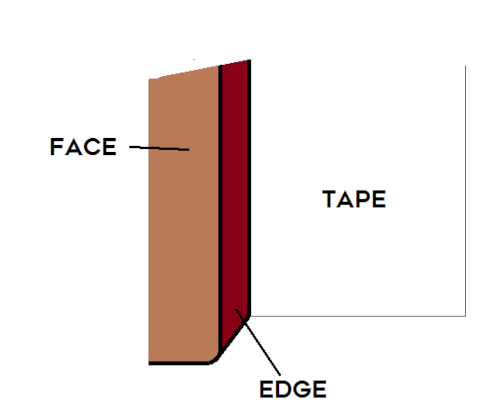How do you finish the edges of a paddle: cut the glass square at the edge of the wood. taper the wood and extend the glass a short distance from the wood, you can't wrap the glassm around the edge because that is too sharpe of curve?
Well if you're not going to use bone edges, I've seen commercially-made paddles that use epoxy edges. I copied that for the tapered back edge of a rudder and it works really well. If/when it does chip, it's easy to fix. The process is like putting a big fat fillet on the edge of your paddle and sanding it to shape. It works for any application where you need a tough edge that's easy to maintain. Here's how I did it:
1. Leave the wooden edges square.
2. At the edge of the paddle blade, run a 2" wide piece of clear plastic packing tape along the entire length of the edge. About 1/2" of the tape width should be firmly attached to the bottom face; the rest just hangs out in the air. NOTE - if you're using a splintery wood like red cedar, removing the tape WILL pull up splinters. In that case the wood (at least under the tape) should be coated with epoxy and allowed to cure before the tape is applied. That will prevent splinters.
3. Put a stiff mixture of epoxy and woodflour in the angle where the tape and edge meet. The bead should be as high as the edge and twice as wide as the edge is high.
4. Fold the tape up along the bead onto the front face. This will trap the epoxy/woodflour putty against the edge. Attach the tape firmly to the front face. Watch out for air bubbles.
5. When the epoxy cures (I'd give it a couple of days), take off the tape and you will have a rough epoxy edge on your paddle. It will be ready for sanding to its final shape. If any air bubbles have formed, they can be filled with more putty and sanded.
Note that depending on the brand of the tape, you may be able to squeeze it into an approximation of the final shape and eliminate some sanding.
Have fun,
Laszlo

thank you
I tried it last night and was not very satisfied with the results:a large amount of air pockets and the bending of the tape created a "fat" edge requiring alot of sanding. I used blue edging tape for painting, which kept me from seeing the air pockets while doing this. Tonight I attempted a slight modification of the describe method. 1) applied the tape to the bottom, 2) applied the resin puddy and 3) applied tape to the top edge, over the puddy, onto the bottom tape sticking out. This avoided the round fat edge from bending the tape, but mimiced the fiber glass cloth creating a feathered edge. Hopefully it will also avoid air pockets and reduce the sanding.
I'll find out tomorrow!
Cool. Definitely curious about how it works.
I actually preferred the fat edge. I could never get cast feathered edges symmetrical and even. One side would always be larger and there'd be a lot of waviness. Instead of fighting it at the casting stage, I made it thicker, let it do what it wanted to and then we had a counseling session with Mr. Beltsander as facilitator to fix the error of its ways.
If you were able to cast it directly into the desired shape, you'll definitely need to share that accomplishment.
Laszlo